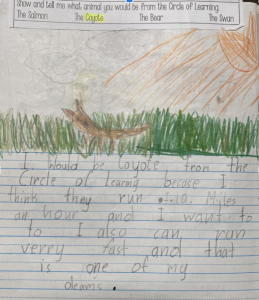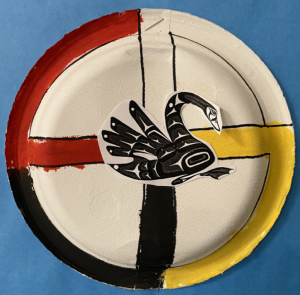9 Circle of Learning
Courtney Chisholm and Katelyn Bouvier
Contributors’ Biographies:
Katelyn Bouvier is a fourth-year student at KPU who aspires to become an Elementary School Teacher. Katelyn self-identifies as Métis and is in the process of applying for a Métis Nation BC Card. Katelyn is passionate about integrating Indigenous education in their future classroom and looks forward to using resources provided in this Pressbook in their future career.
Courtney Chisholm is a fourth-year student graduating this year with a Bachelors of Arts in General Studies and a minor in Counselling. Courtney will continue their education at University of the Fraser Valley, where they will become an elementary school teacher.
Resource Overview
Digital Book Weblink:
Pol, M.V., & Bull, R. (2016). Circle of learning. Storyjumper. https://www.storyjumper.com/book/read/40907066/Circle-of-Learning
Grade Level: Kindergarten – Grade Three
Description:
This story-based resource is similar in format to a social story and includes keywords in the Secwepemctsín language of the Secwepenc Interior Salish Indigenous Peoples. The story shares an educational journey of a Secwepemc First Nations girl, Tsetsé7 (little sister), and her four friends: Sqlélten (salmon), Sek’lép (coyote), Kénkéknem (bear), and Speqmic (swan). Grandfather Speqmic loves to share stories with Tsetsé7, and her favourite of all is The Circle of Learning. The story carries on to explain the different symbolic “Circles of Learning”: the four colours, the four directions, the four seasons, the four animals, and the four learning goals. The story concludes by expressing that everyone and every place is part of the Circle of Learning, making us all special and unique.
Significant Indigenous Knowledge:
The Circle of Learning is divided into four components, and each of its lessons consists of four elements. The lessons represent different Indigenous teachings. Therefore, familiarity with sacred meanings is essential. The lessons consist of four colours, four directions, four animals, four seasons, and four learning goals.
The colours lesson teaches the various symbolic meanings of the colours it illustrates. For example, red, black, yellow, and white are the colours of the Medicine Wheel, an Indigenous teaching tool, and spiritual guide. White is associated with the North and birth, yellow, the East and childhood, red, the South and adulthood, and black with West and Elders (Four Directions Teaching, n.d). The Medicine wheel is interpreted differently by different Nations, and the Learning Circle depicts other representations of their teachings (Minister of Indian Affairs, 2010).
Each of the aforementioned directions signifies the learning journey of an individual. Healing and learning demand the continuous and ongoing reflection of oneself about others. Therefore, while shifting through the four directions, a balance must be maintained while the individual embraces change (Joseph, 2020).
The four seasons are also depicted in the Learning Circle lesson. They are part of the natural, dynamic process of change and the circle of life. Each season creates a cycle in nature, which corresponds to changes in lifestyle, food, social activities, religious and spiritual practices, as well as economic pursuits. Spring signifies renewal and a time for Indigenous Peoples to plant the seeds for harvest, bringing new life to Mother Earth. Summer is the time for hunting, gathering, and harvesting the fruits of their labour. Autumn is the end of the harvesting season when the last of the crops are collected then stored for winter. Lastly is the winter season, known as the storytelling season. It is a time for Elders to engage youth and embrace the long cold nights by using storytelling to socialize, instruct and entertain. (McCues & Associates for Indian and Northern Affairs Canada, 2010).
Each animal embodies unique gifts of learning. Beginning with the blessings of the salmon, this animal holds the ability to “navigate the environment and other systems” by modelling to participants how to use critical thinking skills. The gift of the coyote influences participants to embrace every aspect that makes up who they are. The bear’s gift invites participants to become more self-aware by fostering a strong sense of belonging. The gift of the swan is relational, encouraging participants to use their social and emotional skills to create a supportive environment (Pol & Bull, 2016).
Necessary Prior Knowledge:
Before using this resource, it is recommended that the educator becomes familiar with the pronunciation of Secwepemctsín keywords presented in this social story. Familiarization of words would best happen by downloading the story’s audiobook and listening to the proper pronunciations. The facilitator should also review information on the five different Circles of Learning. It is recommended that the educator inform themselves of the significance of the four learning goals: resilience, knowing the culture, relationships, and a sense of belonging relative to Indigenous Voices. Furthermore, the educator should prepare strategies that can connect participants to these four values, encouraging participants to make personal connections. Lastly, facilitators should educate themselves upon the symbolic meaning behind the four animals (salmon, coyote, swan, bear) before continuing to the recommended activity.
Suggested Learning Activities
One activity that would complement this resource would be outlining each symbolic representation of the four animals: Sqlélten (salmon), Sek’lép (coyote), Kénkéknem (bear), and Speqmic (swan). As the symbolic meanings are outlined within the resources, it is recommended that the facilitator reads these out loud to the class. After, invite participants to reflect on which animal they connect with and feel they relate with the most. When participants have chosen an animal, provide them with the following journaling question; “Draw and share what animal you would be from the Circle of Learning”. While giving participants time to complete this activity, the facilitator should discuss the reasoning behind their choice.
A second activity that may utilize participants’ artistic abilities, would be by creating a hand painted Circle of Learning. Begin by gathering white, yellow, red, and black paints, as well as a classroom set of paintbrushes and white paper plates. After distributing needed art materials, direct participants step by step how to paint the Circle of Learning. Once complete, supply participants with pictures of their chosen animal to glue into the centre of the plate. Allow the plate time to dry and create a classroom display of participants’ finished products.


The Learning Circle
Image by: Katelyn Bouvier BY-NC-ND (Attribution Non-Commercial No Derivatives)
References
Four Directions Teaching. (n.d.). http://www.fourdirectionsteachings.com/interactive.html.
Joseph, B. (2020). What is an Indigenous medicine wheel? Indigenous Corporate Training Inc. https://www.ictinc.ca/blog/what-is-an-indigenous-medicine-wheel
McCue, H., & Associates for Indian and Northern Affairs Canada. (2010). The learning circle. https://www.aadnc-aandc.gc.ca/DAM/DAM-INTER-HQ/STAGING/texte-text/ach_lr_ks_clsrs_learningcircle_lc47_1316538044949_eng.pd
Pol, M.V., & Bull, R. (2016). Circle of learning. Storyjumper. https://www.storyjumper.com/book/read/40907066/Circle-of-Learning

